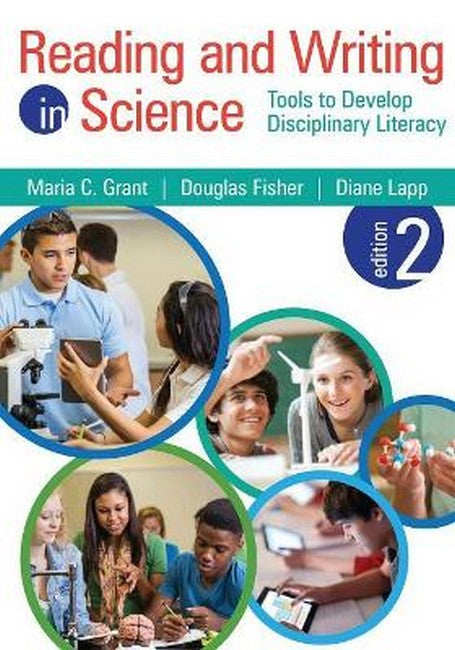Maria C. Grant, EdD, is a professor in the Department of Secondary Education at California State University Fullerton and the director of the Single Subject Credential Program at CSUF. She works with both pre-service and in-service teachers in the credential program and at school sites. Her work includes research and publications in the areas of disciplinary literacy, literacy in the content areas, science education, and pedagogy. In addition to her efforts at the university, Maria's experience includes many years of teaching in high school and middle school science classrooms. She has taught physics, oceanography, coordinated science, chemistry, and earth science. She currently supports learners as teacher and coach at Health Sciences High & Middle College. Over the years, Maria has acted as a leader in curriculum development and professional development at both the school and district levels. Her most recent efforts include research and professional development work centered on reading, writing, and language within content classrooms. Maria can be reached at mgrant@fullerton.edu. Follow her on twitter at @mgrantfullerton Douglas Fisher is professor and chair of educational leadership at San Diego State University and a leader at Health Sciences High and Middle College. Previously, Doug was an early intervention teacher and elementary school educator. He is a credentialed teacher and leader in California. In 2022, he was inducted into the Reading Hall of Fame by the Literacy Research Association. He has published widely on literacy, quality instruction, and assessment, as well as books such as Welcome to Teaching, PLC+, Teaching Students to Drive their Learning, and Student Assessment: Better Evidence, Better Decisions, Better Learning. Diane Lapp, EdD, is a distinguished professor of education at San Diego State University where her work continues to be applied to schools. She is also an instructional coach and teacher at Health Sciences High & Middle College. Throughout her career, Diane has taught in elementary, middle, and high schools. Her major areas of research and instruction regard issues related to the planning and assessment of very intentional literacy instruction and learning. A member of both the California and the International Reading Halls of Fame, Diane has authored, coauthored, and edited numerous articles, columns, texts, handbooks and children's materials on instruction, assessment, and literacy related issues. Diane is the recipient of the ILA 2023 William S. Gray Citation of Merit, a prestigious award reserved for those who have made outstanding contributions to multiple facets of literacy development. Diane can be reached at lapp@sdsu.edu. Follow her on twitter @lappsdsu
Request Academic Copy
Please copy the ISBN for submitting review copy form
Description
Introduction New to This Edition About the Authors 1. Teaching Students to Think Like Scientists How Well Are U.S. Students Doing in Science? What Foundations Do We Need to Have in Place? What Are the Features of Purposeful Science Instruction? What Do Real-World Scientists Do? 2. Knowing and Using Scientific Language to Communicate Like a Scientist Language Is the Foundation for Learning Using Language in Science Connecting the Common Core State Standards and the Next Generation Science Standards Next Generation Science Standards Support the Precision of Language Use Science Instruction Assess to Instruct: Developing Knowledge and Language Fostering Independent Word Learning in Science Word Play Promotes Increased Vocabulary Knowledge 3. Reading Like a Scientist Connecting the Next Generation Science Standards and the Common Core State Standards Features That Make Texts Complex Teaching Students to Read Science Texts Collaborative Conversations Support Learning and Sharing Scientific Language and Concepts The Connection Between Vocabulary and Reading Success Why Teach Reading in Science? 4. Writing Like a Scientist Connecting the Common Core State Writing Standards and the Next Generation Science Standards Writing Like a Scientist Is Different WebQuest: Collecting Data for Writing Writing Frames: Scaffolds for Scientific Writing Teaching Scientific Phrasing Writing Formats in Science Writing Well-Supported Arguments Why Learn to Write Like a Scientist? 5. Assessing Student Learning in Science The Purpose of Assessment in Science Using Assessment Information Identifying Literacy-Language Strengths and Needs Creating Science Assessments Final Thoughts About Assessment References Index
"The authors of Reading and Writing in Science bring together expertise in Next Generation Science Standards, English language arts, and excellent teaching methods to produce an eminently readable guide for the novice and experienced teacher. Teachers who wish to teach science while improving their students' reading and writing skills will find a wealth of practical ideas in this volume. The many practical ideas in this volume demonstrate that improving students' skills in reading and writing can also improve their understanding and abilities in science." -- Cary Sneider, Associate Research Professor "Reading and Writing in Science is a teacher friendly book that drew me in from the introduction to the end. Through real life scenarios combined with useful methods for instruction, it illustrates how science teachers can use language as a tool for teaching science." -- Trina Allen, Science Content Specialist The real strength of the book is the almost equal weighting given to the four strands of literacy; oral, aural, reading and writing. This provides a useful prompt for the reader to go beyond the obvious when incorporating a greater literacy focus into their curriculum. -- Kristy Turner

